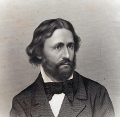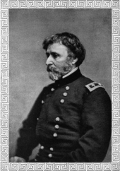John C. Frémont: 'The Pathfinder'
John Charles. Frémont was born in Savannah, Ga., on Jan. 21, 1813, to parents who were not married. His father died when John was young, and John got a job as a law clerk. He studied astronomy, classics, and mathematics at school and attended Charleston College from 1828 to 1830. He served as a math instructor for the United States Navy for a few years in the 1830s. He soon found the call of the West too much to ignore and took a job as a civil engineer's assistant, exploring the newly acquired Louisiana Territory north of the Missouri River. He also was on the lookout for an overland route from the Mississippi River to the Pacific Ocean. 
Frémont fell in love with Jessie Benton, whose father was Thomas Hart Benton, a powerful Senator from Missouri. John and Jessie ran away together to get married. Her father was at first outraged but changed his mind and agreed to help John's career. Benton was one of a handful of Congressmen who were vocal proponents of the idea of Manifest Destiny, that Americans had a duty to explore and settle all the way to the West Coast. Benton secured for Frémont the job as the leader of an 1842 expedition to explore the West, from the Mississippi River to the Rocky Mountains. The famous outdoorsman Kit Carson was in the party that accompanied Frémont on this assignment. Frémont himself climbed a tall peak and place an American flag on top. Frémont became well-known for this expedition and even moreso for the report that he wrote about the expedition. He employed his astronomical training to build tables of geographical data and also published a narrative account of his journey. Benton saw that the Senate published Frémont's account in 1843, and the general public found it enjoyable reading. People especially appreciated his effort to plant a U.S. flag on top of a tall mountain. 
He was back out West in 1843–1844, seeking a route across the Rockies to Oregon. They found it and then went to California, crossing the difficult and dangerous Sierra mountain range in the process. Frémont visited Sutter's Fort, run by John Sutter of California Gold Rush fame, in 1844 and then returned to Washington, where he wrote up a report of his second western expedition. He put both reports into one book and published that; again, his writings were very popular, with some settlers saying that reading his reports was the reason that they decided to head west. He went on five expeditions in all. He became known as "The Pathfinder." Frémont found his way to California and served in the California Volunteers and the United States Mounted Rifles. He was involved in the Bear Flag Revolt, a short-lived protest by Americans in California against Mexican rule. He fought in the Mexican-American War, leading the California Battalion in several operations, including the capture of Santa Barbara and a part of Los Angeles. He was among the signers of the Treaty of Cahuenga, which ended the war in most of California. Frémont was appointed Governor of California but, when told to vacate the office, refused and was removed from office and tried by the U.S. Army for mutiny, stemming from his refusal to recognize the authority of Stephen Kearny, the Army general in charge of organizing a new territorial government. Frémont was found guilty, but then-President James K. Polk pardoned him. Gold was discovered on land that he owned, Las Mariposas and he found his new career as a politician in 1850, after California was admitted into the Union. The people of California elected Fr&233;mont as one of their two Senators. He served for a short time. He was the first presidential nominee of the Republican Party, formed in 1854. Frémont ran in 1856, losing to James Buchanan. 
In 1861, President Abraham Lincoln appointed Frémont a major general in the Union Army, giving him command of the western military district. Under his command, Union troops first lost and then regained control of Springfield, a town in Missouri. One of the people he appointed to a position of command during this time was Ulysses S. Grant future Union Army commander and President. Frémont served as commander for a few months and tried to bring Missouri into the war on the side of the Union. Lincoln didn't agree with his methods and relieved him of the overall western command, offering him another appointment, as commander of the mountain department, a role that he had for two years. He led a group of soldiers up against the famed Confederate General Stonewall Jackson; the battle was a stalemate, and Jackson escaped capture. A reorganization put Frémont under a soldier he didn't like, and made his displeasure known enough that he was relieved of command. He resigned from the Army for good in 1864 and ran again for President, this time as the nominee of the Radical Democracy Party. He withdrew his name from consideration just before the election. After the Civil War, Frémont fell on hard times because of a series of bad investments. The Arizona Territory in 1878 appointed Frémont its territorial governor, and he had the position until 1881. In the last years of his life, Frémont secured another appointment as a U.S. Army major general, this time on the retired list. He died in 1890. Among his achievements were the discovery and naming of the Great Basin in Utah. |
|
Social Studies for Kids
copyright 2002–2025
David White




